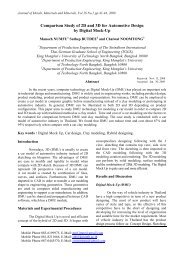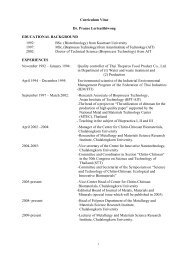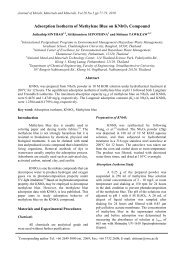Characterization and Drug Behavior in Shellac Wax – Poloxamer ...
Characterization and Drug Behavior in Shellac Wax – Poloxamer ...
Characterization and Drug Behavior in Shellac Wax – Poloxamer ...
Create successful ePaper yourself
Turn your PDF publications into a flip-book with our unique Google optimized e-Paper software.
72<br />
some of them was not dispersed or molecular<br />
<strong>in</strong>teracted with the bases <strong>and</strong> it would be gradually<br />
dissolved <strong>and</strong> released from the matrix base.<br />
Accord<strong>in</strong>g to the result, The HCT release rate was<br />
slower than Pro from 5:5 bases ratio.<br />
Pro<br />
HCT<br />
Figure 4. Release of HCT <strong>and</strong> Pro from L: S matrix<br />
tablets; pure L (10:0), mixture of L <strong>and</strong> S<br />
(5:5) <strong>and</strong> pure S (0:10).<br />
<strong>Drug</strong> Release K<strong>in</strong>etic<br />
Many mathematic models could be applied<br />
to describe the mechanism of drug release. Zero<br />
order k<strong>in</strong>etic described the system with the drug<br />
release rate did not depend on time. First order<br />
k<strong>in</strong>etic was expressed for the release with the drug<br />
concentration dependent. Higuchi’s model was<br />
expla<strong>in</strong>ed the diffusion of drug through the matrix<br />
system. Power law model was popularly used<br />
because it could be determ<strong>in</strong>ed many k<strong>in</strong>etic by n<br />
exponent value. Cube root law was evaluated to<br />
describe the release of drug from the erosion of<br />
matrix system which geometrical constant (9) .<br />
Release k<strong>in</strong>etic of both Pro <strong>and</strong> HCT <strong>in</strong>corporated<br />
<strong>in</strong> L were fitted well with the cube root law.<br />
Theoretically, Pro should release from the matrix<br />
tablet from both erosion <strong>and</strong> diffusion control<br />
CHONCHEEWA, C. <strong>and</strong> PHAECHAMUD, T.<br />
which could be expla<strong>in</strong>ed by first order. However,<br />
the erosion rate of L might faster than the<br />
dissolution <strong>and</strong> diffusion of the drug from the<br />
matrix hence Pro <strong>in</strong> the tablet made from L ma<strong>in</strong>ly<br />
released by erosion of the base which could<br />
ma<strong>in</strong>ta<strong>in</strong> the constant geometric shape through the<br />
dissolution time. Pro dispersed <strong>in</strong> 5:5 L:S matrix<br />
tablet released by first order k<strong>in</strong>etic which could be<br />
confirmed by the n exponent from power law<br />
expression. This hydrophilic drug could easily<br />
dissolve <strong>and</strong> diffuse from the matrix tablet<br />
simultaneously with the erosion of the matrix<br />
tablet. The matrix tablet made from L has high<br />
erosion rate which could completely release the<br />
entire drug with<strong>in</strong> 180 m<strong>in</strong>. However, <strong>in</strong> case of<br />
5:5 L:S matrix tablet, the erosion rate was deducted<br />
by S hence the release was not ma<strong>in</strong>ly by the<br />
erosion of L but the release occurred from both<br />
diffusion control <strong>and</strong> erosion control which could<br />
be the best described by first order release k<strong>in</strong>etic.<br />
In the other h<strong>and</strong>, HCT <strong>in</strong>corporated <strong>in</strong> 5:5 L:S<br />
matrix system was the best described by zero order<br />
k<strong>in</strong>etic which could be confirmed by n exponent<br />
value of power law model. Generally, the surface<br />
area was gradually decreased as dissolution time<br />
<strong>in</strong>creased, resulted <strong>in</strong> the decrement of drug<br />
release. In case of 5:5 L:S matrix system surface<br />
area of tablet was gradually decreased because of<br />
the barrier property of S which could obstruct the<br />
water penetration <strong>in</strong>to the matrix tablet. As<br />
described previously, HCT was not completely<br />
dispersed or molecular <strong>in</strong>teracted <strong>in</strong> 5:5. When<br />
dissolution medium penetrated <strong>in</strong>to the matrix<br />
tablet, the matrix was gradually eroded<br />
simultaneously with the dissolution of dispersed<br />
drug. In the other h<strong>and</strong>, the non-dispersed drug was<br />
gradually dissolved <strong>and</strong> diffused out from the pore<br />
of the eroded surface. Some of them might appear<br />
at the eroded surface <strong>and</strong> gradually release <strong>in</strong>to the<br />
dissolution medium. The non-dispersed component<br />
could compensate the drug release from the<br />
decrement of surface area. The balance between<br />
matrix erosion <strong>and</strong> drug dissolution might result <strong>in</strong><br />
the zero order release k<strong>in</strong>etic. For both drugs <strong>in</strong> S<br />
(0:10), they could not release from the matrix<br />
system therefore the release k<strong>in</strong>etics could not be<br />
determ<strong>in</strong>ed. The r 2 <strong>and</strong> msc values from dissolution<br />
profile fitt<strong>in</strong>g for the other systems are shown <strong>in</strong><br />
Table. 3.






